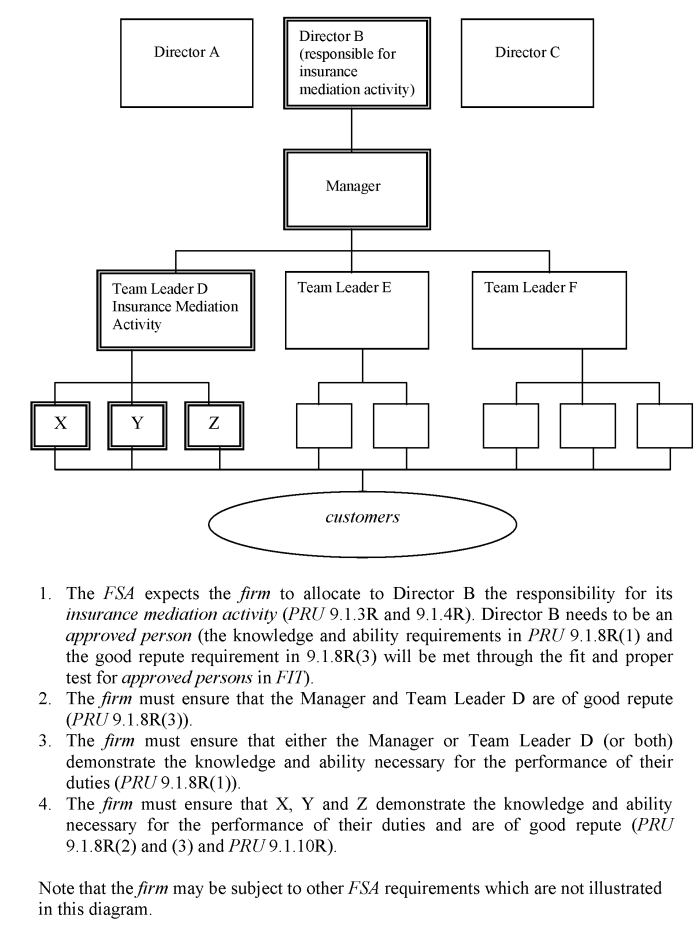PRU 9.1 1 Responsibility for insurance mediation activity
Application
This section applies to a firm with Part IV permission to carry on insurance mediation activity.
Purpose
The main purpose of PRU 9.1.3 R, PRU 9.1.8 R and PRU 9.1.10 R is to implement in part the provisions of the Insurance Mediation Directive as these apply to firms regulated by the FSA.
Responsibility for insurance mediation activity
The firm may allocate the responsibility for its insurance mediation activity under PRU 9.1.3 R to an approved person (or persons) performing:
-
(1)
a governing function (other than the non-executive director function)2; or
- (2)
-
(3)
the significant management (other business operations) function.
-
(1)
Typically an insurance intermediary will appoint a person performing a governing function (other than the non-executive director function) 2to direct its insurance mediation activity. Where this responsibility is allocated to a person performing another function, the person performing the apportionment and oversight function with responsibility for the apportionment of responsibilities under SYSC 2.1.1 R must ensure that the firm's insurance mediation activity under PRU 9.1.3 R is appropriately allocated.
-
(2)
The descriptions of significant influence functions, other than the required functions, do not extend to activities carried on by an insurance intermediary with permission only to carry on insurance mediation activity and whose principal purpose is to carry on activities other than regulated activities (see SUP 10.1.21 R). In this case, the firm may allocate the responsibility for the firm's insurance mediation activity under PRU 9.1.3 R to one or more of the persons performing the apportionment and oversight function who will be required to be an approved person.
-
(3)
In the case of a sole trader, the sole trader will be responsible for the firm's insurance mediation activity, whether or not he is himself a person approved to perform the sole trader function2.
Where a firm has appointed an appointed representative to carry on insurance mediation activity on its behalf, the person responsible for the firm's insurance mediation activity will also be responsible for the insurance mediation activity carried on by an appointed representative.
The FSA will specify in the FSA Register the name of the persons to whom the responsibility for the firm's insurance mediation activity has been allocated under PRU 9.1.3 R by inserting after the relevant controlled function the words "(insurance mediation)". In the case of a sole trader, the FSA will specify in the FSA Register the name of the sole trader as the 'contact person' in the firm.2
Knowledge, ability and good repute
An insurance intermediary must establish on reasonable grounds that:
-
(1)
a reasonable proportion of the persons within its management structure who are responsible for insurance mediation activity; and
-
(2)
all other persons directly involved in its insurance mediation activity;
demonstrate the knowledge and ability necessary for the performance of their duties; and
-
(3)
all the persons in its management structure and any staff directly involved in insurance mediation activity are of good repute.
In determining a person's knowledge and ability under PRU 9.1.8 R (1) and PRU 9.1.8 R (2), the firm should have regard to matters including, but not limited to, whether the person:
-
(1)
has demonstrated by experience and training to be able, or that he will be able, to perform his duties related to the firm's insurance mediation activity; and
-
(2)
satisfies the relevant requirements of the FSA's Training and Competence sourcebook (TC).
In considering a person's repute under PRU 9.1.8 R (3), the firm must ensure that the person:
-
(1)
has not been convicted of any serious criminal offences linked to crimes against property or other crimes related to financial activities (other than spent convictions under the Rehabilitation of Offenders Act 1974 or any other national equivalent); and
-
(2)
has not been adjudged bankrupt (unless the bankruptcy has been discharged);
under the law of any part of the United Kingdom or under the law of a country or territory outside the United Kingdom.
For the purposes of PRU 9.1.10 R (1), the firm should give particular consideration to offences of dishonesty, fraud, financial crime or other offences under legislation relating to banking and financial services, companies, insurance and consumer protection.
Firms are reminded that Principle 3 requires firms to take reasonable care to organise and control their affairs responsibly and effectively. Principle 3 is amplified in SYSC 3.1.1 R which requires firms to take reasonable care to establish and maintain such systems and controls as are appropriate to its business. A firm's systems and controls should enable it to satisfy itself of the suitability of anyone who acts for it (SYSC 3.2.13 G). This includes the assessment of an individual's honesty and competence. In addition, TC lists some general, high level commitments to training and competence which every firm should make and fulfil.
PRU 9 Ann 1 G gives an example of how the FSA would expect firms to comply with the requirements in PRU 9.1.3 R, PRU 9.1.4 R, PRU 9.1.8 R and PRU 9.1.10 R.

